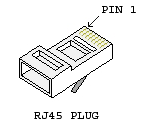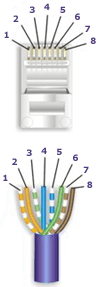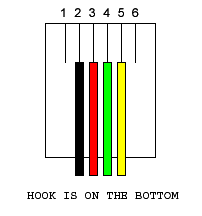Network Cables - Cat5e and RJ45
Cat5e is short for Category 5e Cable. Cat5e superceeds Cat5 cable, and is the most common type of cable about at the moment - so we'll just talk about Cat5e. The "e" stands for "enhanced".
Cat5e cables should not be longer than 100m. Cables can be solid core, or stranded (meaning lots of wires per pin). Stranded is ideal for patch cables, whereas building wiring is normaly solid core.
Cat5e is the cable and 8P8C (or RJ45) are the connectors commonly used on ethernet 1000BaseT ethernet cabling. It provides performance of up to 100MHz, and can be used for 1000 Mbit/s Ethernet networks.
The 8P8C connector is commonly incorrectly called an RJ45 connector. 8P8C stands for eight position, eight conductors - meaning all eight pins are connected to wires.
Straight through cables (or patch leads) are wired with 568B standard on both ends. This is the most common type of lead around.
 |
|
Crossover cables are wired with 568A on end, and 568A on the other end. These cables are only used if you are connecting two computers directly together without a internet hub.
Cat6 cables are slowly becoming more readily available. Cat6 provides performance of up to 250MHz. Cat6a was released recently (Feb 2008) with a performance of 500MHz and 10 Gbit/s Ethernet networks. At the moment we don't have many devices that run at these speeds, but that will change. Cat6 is backward compatible with Cat5e - so the Cat6 cables plug into the Cat5e gear. They actually use the same 8P8C (RJ45) connector.
Telephone Cables - RJ11/RJ14
The most common telephone connector in the world is the RJ11/RJ14 connector. The RJ11 and RJ14 are identical jacks and will fit in the same socket - but the RJ11 is usually wired with two wires and the RJ14 is wired with 4 wires.
The RJ11 configuration is also called a 6P2C connector - or 6 position, 2 conductors.
The RJ14 configuration is also called a 6P4C connector - or 6 position, 4 conductors.
|
|
|
The four wires are usually characterised as a red and green pair, and a black and yellow pair. The yellow is sometimes white.
The red and green pair typically carry voice or data. Anolog gear such as old phones, faxes and modems just use the two wires.
On more sophisticated phones and digital equipment use the black and yellow pair for Iow-voltage signals such as phone lights, displays, etc.
Reference:


